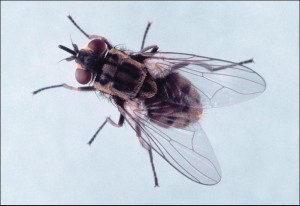We often consider the end of summer a time when nuisance insects are decreasing in numbers, but there is one insect that is reaching peak numbers at this time of year. The Stable Fly or Dog fly, Stomoxys calcitrans, can occur at all times of the year, but populations are heaviest in late Summer through early Winter along the Gulf Coast.
Resembling the common house fly, stable flies are persistent pests in their search for a blood meal. They have a painful bite due to specialized mouthparts that resemble sharp thorns that rasp the skin. Luckily, most people do not have an allergic reaction following a bite.
Stable flies breed in many types of moist or decaying vegetation, including seaweed deposits along the beach. Each female can lay about 500 eggs and the typical fly maggots feed in the vegetation before pupating into the adult. The entire life cycle takes several weeks.
Spraying a pesticide to control adult stable flies outdoors is not a practical option for homeowners. Rather, control methods should be directed at their breeding sites to reduce numbers. This includes allowing manures, plant debris, or crop residues to dry quickly by spreading them thinly over an area or composting them properly.
Following hurricane events, local agencies may manage stable fly populations with pesticides, but these flies do not often warrant the use of such limited resources for control.
For more information, consult this UF / IFAS publiction about the Stable Fly.
 0
0

